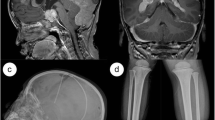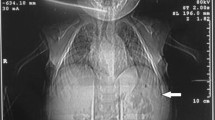Abstract
Introduction
Langerhans cell histiocytosis (LCH) is a multisystem disorder of unknown etiology and characterized by accumulation of histiocytes in various tissues.
Case report
A 3-year-old, previously healthy girl presented with progressive flattening of the parietal convexity for 6 months and seborrheic eczema of the scalp. At presentation, the patient showed no neurological deficit. The eczemas were extensively distributed over the scalp, but not found in any other site of the body. Blood examination revealed a marked increase in soluble interleukin-2 receptor levels. Neuroimages revealed multiple calvarial defects that were replaced by well-demarcated, enhancing extracerebral masses. A biopsy surgery confirmed the diagnosis as LCH.
Conclusion
LCH may cause progressive calvarial defects. If seborrheic eczemas are concurrent, they may suggest prompt histological verification and treatments be initiated.




Similar content being viewed by others
References
Ishii R, Morimoto A, Ikushima S, Sugimoto T, Asami K, Bessho F, Kudo K, Tsunematsu Y, Fujimoto J, Imashuku S (2006) High serum values of soluble CD154, IL2 receptor, RANKL and osteoprotegerin in Langerhans cell histiocytosis. Pediatr Blood Cancer 47(2):194–199
Rosso DA, Roy A, Zelazko M, Braier JL (2002) Prognostic value of soluble interleukin 2 receptor levels in Langerhans cell histiocytosis. Br J Haematol 117(1):54–58
Pakula AS, Paller AS (1993) Langerhans cell histiocytosis and dermatophytosis. J Am Acad Dermatol 29(2 Pt 2):340–343
Hong B, Hermann EJ, Klein R, Krauss JK, Nakamura M (2010) Surgical resection of osteolytic calvarial lesions: clinicopathological features. Clin Neurol Neurosurg 112(10):865–869
Prayer D, Grois N, Prosch H, Gadner H, Barkovich AJ (2004) MR imaging presentation of intracranial disease associated with Langerhans cell histiocytosis. AJNR Am J Neuroradiol 25(5):880–891
Belen D, Colak A, Ozcan OE (1996) CNS involvement of Langerhans cell histiocytosis. Report of 23 surgically treated cases. Neurosurg Rev 19(4):247–252
Oliveira M, Steinbok P, Wu J, Heran N, Cochrane D (2003) Spontaneous resolution of calvarial eosinophilic granuloma in children. Pediatr Neurosurg 38(5):247–252
Munn SE, Olliver L, Broadbent V, Pritchard J (1999) Use of indomethacin in Langerhans cell histiocytosis. Med Pediatr Oncol 32(4):247–249
Flores LG 2nd, Hoshi H, Nagamachi S, Ohnishi T, Watanabe K, Fukiyama J, Nao-i N, Sawada A (1995) Thallium-201 uptake in eosinophilic granuloma of the frontal bone: comparison with technetium-99m-MDP imaging. J Nucl Med 36(1):107–110
Holley A (2010) Sonographic diagnosis of unifocal Langerhans cell histiocytosis of the skull. J Clin Ultrasound 38(8):440–442
Yamaki T, Kokubo Y, Saito Y, Matsuda K, Funiu H, Sakurada K, Sato S, Kayama T (2014) A case of Langerhans cell histiocytosis of the skull in which preoperative methionine positron emission tomography was useful in comprehending the spreading of the lesion. Surg Neurol Int 5:27
Acknowledgments
This work was not supported by a grant.
Author information
Authors and Affiliations
Corresponding author
Ethics declarations
Conflict of interest
The authors declare no competing interests concerning either the materials and methods, or the findings presented in this study.
Rights and permissions
About this article
Cite this article
Tsutsumi, S., Nakajima, S., Oda, H. et al. Langerhans cell histiocytosis with seborrheic eczema of the scalp and extensive calvarial involvement. Childs Nerv Syst 32, 1337–1341 (2016). https://doi.org/10.1007/s00381-016-3026-1
Received:
Accepted:
Published:
Issue Date:
DOI: https://doi.org/10.1007/s00381-016-3026-1




